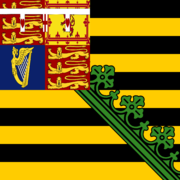
The Royal Standard
of The Duchy of Saxe-Coburg-Gotha.
Date: 1826-1920.
Author: Duke of The Duchy of Saxe-Coburg-Gotha,
designed by Queen Victoria.
(Wikimedia Commons)

English: Flag of The Duchy of Saxe-Coburg & Gotha, 1911-1920.
Deutsch: Flagge des Herzogtums Sachsen-Coburg & Gotha 1911-1920.
Date: 9 June 2006.
Source: Own work.
Author: David Liuzzo.
(Wikimedia Commons)
The following Text is from Wikipedia - the free encyclopaedia.
Saxe-Coburg and Gotha (German: Sachsen-Coburg und Gotha), or Saxe-Coburg-Gotha, was an Ernestine Duchy ruled by a Branch of The House of Wettin, consisting of territories in the present-day States of Bavaria and Thuringia, in Germany. It lasted from 1826 to 1918.
The name Saxe-Coburg-Gotha also refers to The Family of The Ruling House of Saxe-Coburg and Gotha, which played many varied roles in the dynastic and political history of Europe in the 19th- and 20th-Ccenturies.

Queen Victoria.
A Member of The House of Saxe-Coburg Gotha.
(1887).
Source: Scanned from the book The National Portrait Gallery
History of The Kings and Queens of England by David Williamson, ISBN 1855142287.
Author: Alexander Bassano (1829–1913).
(Wikimedia Commons)
Before 1867, The Duchy of Saxe-Coburg and Gotha had its own Army. But, on 26 June 1867, because of a Treaty signed in 1866 with Prussia, its Army was added, for defending and recruiting purposes, to the 6th Thuringian Infantry Regiment No. 95 of The 22nd Division of The Army Corps.
Three Battalions of The 6th Thuringian Infantry Regiment were assigned to Gotha (No. 1), Hildburghausen (No. 2) and Coburg (No. 3), but The Corps Headquarters were in Kassel.
Unlike Prussia, where military service was mandatory, Saxe-Coburg and Gotha filled its quota in The Imperial Army with The Draft.
In the early part of the 20th-Century, before The First World War, it was The Family of The Sovereigns of The United Kingdom, Belgium, Portugal, Bulgaria, and Saxe-Coburg-Gotha. In 1910, the Portuguese King was deposed, and the same thing occurred in Saxe-Coburg-Gotha in 1918, and in Bulgaria in 1946.

Queen Victoria married her first cousin, Prince Albert of Saxe-Coburg and Gotha, in 1840. Their nine children married into Royal and Noble Families across the Continent, tying them together and earning her the sobriquet "the grandmother of Europe".
Three Battalions of The 6th Thuringian Infantry Regiment were assigned to Gotha (No. 1), Hildburghausen (No. 2) and Coburg (No. 3), but The Corps Headquarters were in Kassel.
Unlike Prussia, where military service was mandatory, Saxe-Coburg and Gotha filled its quota in The Imperial Army with The Draft.
In the early part of the 20th-Century, before The First World War, it was The Family of The Sovereigns of The United Kingdom, Belgium, Portugal, Bulgaria, and Saxe-Coburg-Gotha. In 1910, the Portuguese King was deposed, and the same thing occurred in Saxe-Coburg-Gotha in 1918, and in Bulgaria in 1946.

Prince Albert.
Date: 1867.
Artist: Franz Xaver Winterhalter (1805–1873).
Current location: NATIONAL PORTRAIT GALLERY, LONDON,
(Wikimedia Commons)
Queen Victoria married her first cousin, Prince Albert of Saxe-Coburg and Gotha, in 1840. Their nine children married into Royal and Noble Families across the Continent, tying them together and earning her the sobriquet "the grandmother of Europe".
After Albert's death in 1861, Victoria plunged into deep mourning and avoided public appearances. As a result of her seclusion, Republicanism temporarily gained strength, but, in the latter half of her reign, her popularity recovered. Her Golden and Diamond Jubilees were times of public celebration.
Her reign of 63 years and seven months is known as The Victorian Era. It was a period of industrial, cultural, political, scientific, and military change within The United Kingdom, and was marked by a great expansion of The British Empire.
Her reign of 63 years and seven months is known as The Victorian Era. It was a period of industrial, cultural, political, scientific, and military change within The United Kingdom, and was marked by a great expansion of The British Empire.
She was the last British Monarch of The House of Hanover. Her son and successor, Edward VII, belonged to The House of Saxe-Coburg and Gotha, the line of his father.
As of 2016, Branches of The Family still reign in Belgium, The United Kingdom, and the other Commonwealth Realms. The former Tsar of Bulgaria, Simeon II (reigned 1943–1946), kept his surname while serving as the Prime Minister of Bulgaria from 2001 to 2005.
